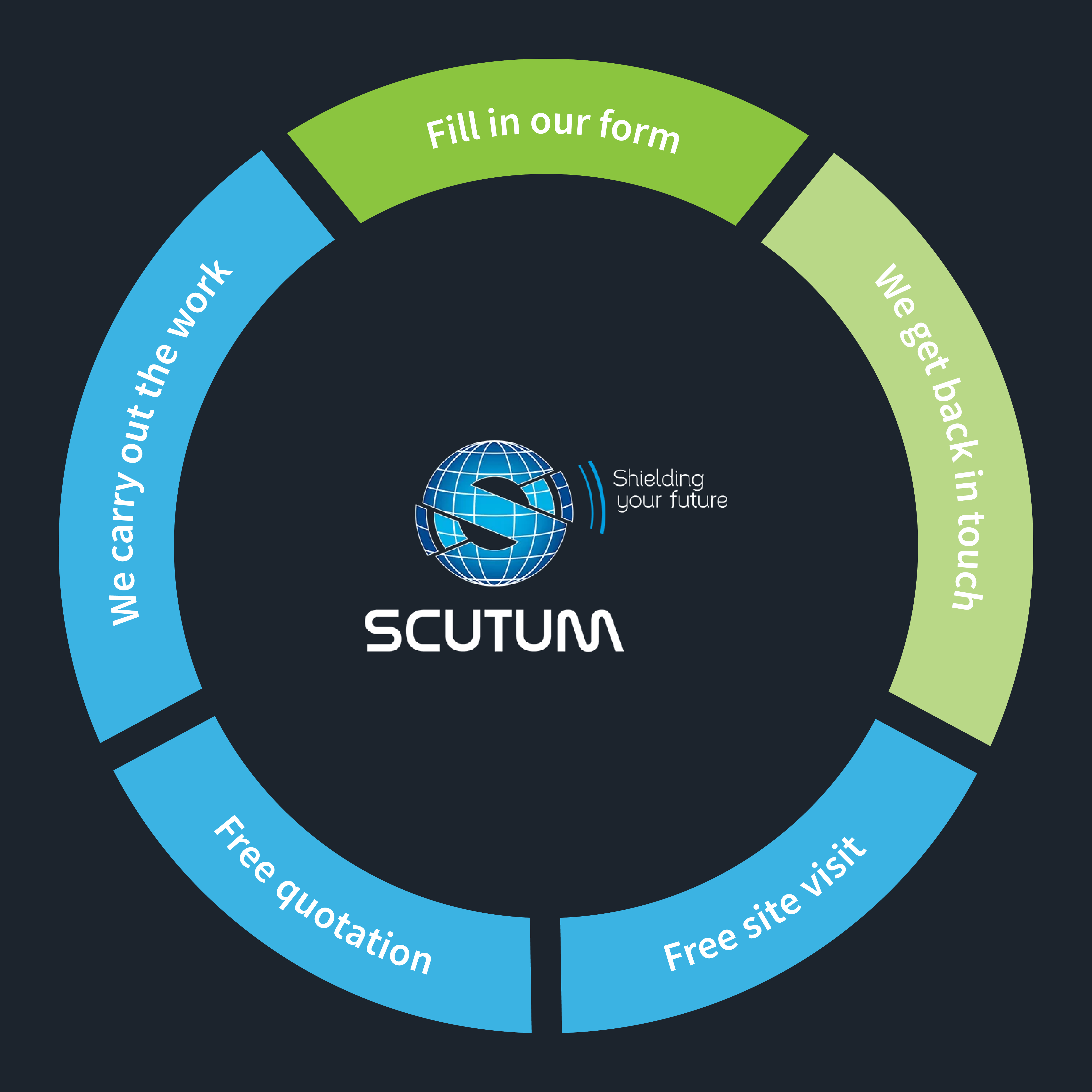Furniture and furnishings fire safety
All homes and business premises are likely to contain several kinds of furniture and furnishings, and while you may have noticed fire safety warnings on the tags, you’ve probably not given much thought to the topic. It turns out that there is a lot of effort which goes into ensuring these items are safe – especially those which use upholstery.
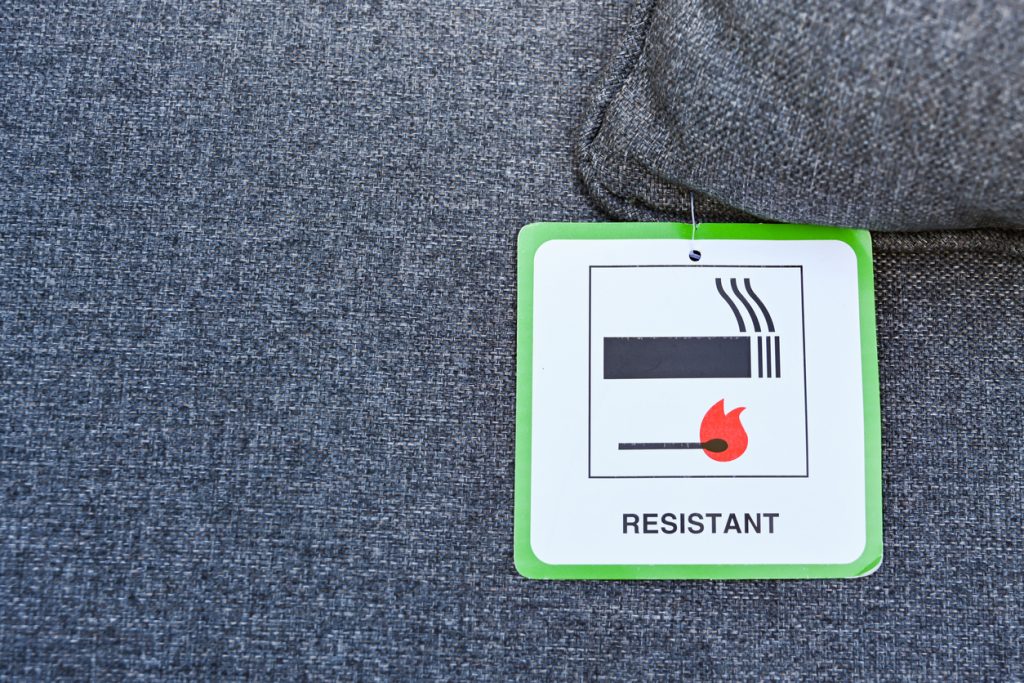
Manufacturers and suppliers of furnishings and furniture must adhere to fire safety regulations in the UK. In this post, we’ll be taking you through the key areas of what is involved in making sure the everyday pieces of furniture in our homes and offices are suitably manufactured and labelled.
What are the current fire regulations for furniture?
The Furniture and Furnishings (Fire Safety) Regulations were introduced in 1988, with updates or amendments made in 1989, 1993 and 2010. They cover the following six main areas:
- Materials used to fill furniture must meet ignition requirements
- Composites of upholstery have to be resistant to cigarettes
- All covers must be resistant to matches
- There must be a permanent label on all new furniture (except mattresses and bed bases)
- Display labels must be attached to every new furniture item where it is to be sold
- A five-year record must be maintained as evidence of compliance by the first supplier when it comes to domestic furniture
Furniture covered by the regulation
Furniture covered by the regulations falls into six categories:
- All upholstered seating, including children’s furniture, upholstered furniture in kit form for self-assembly and second-hand furniture
- Outside furniture that can be used in dwellings (including caravans), caravan upholstery and cane furniture with upholstery
- Beds (divans and bases) and bedding (filling only)
- Scatter cushions and seat pads (filling only)
- Furniture covers
- Foam and non-foam filling material
Does furniture need to be fire rated?
Furniture covered by The Furniture and Furnishings (Fire Safety) Regulations needs to be tested in a UKAS (United Kingdom Accreditation Service) laboratory that meets the BS EN ISO/IEC 17025 international standard.
The tests consist of applying various ignition sources (from a match to a large gas flame) to the different types of materials to ensure that they do not react in such a way that they would pose a fire hazard.
Who is responsible for furniture & furnishings fire safety?
If you are the manufacturer of furniture covered by The Furniture and Furnishings (Fire Safety) Regulations, then you are responsible for ensuring the materials used are in line with the regulations. There should be a certificate from the supplier of the materials you use to show they conform, and where this is not provided, you will require additional material for testing.
If you are importing furniture, you are the first supplier and thus responsible for ensuring the items are tested and that they comply with regulations. You will also need to keep a record of compliance tests for these items. The same applies if you are an importing agent – unless you are only passing orders back to the foreign source.
The Furniture Flammability Test
Fire testing furniture must be carried out according to BS 5852-2006: Methods of test for assessment of the ignitability of upholstered seating by smouldering and flaming ignition sources.
The following flammability tests are carried out with different ignition sources to assess the ignitability of material combinations:
- Ignition Source 0 – This means a smouldering cigarette was used to test the item
- Ignition Source 1 – This means a small gas flame was used to test the item, similar to a match
- Ignition Source 2 – This means a large gas flame was used to test the item, a more intense version of Source 1
- Ignition Source 5 – A crib of wooden planks is used here, with propanediol added and ignited with a match to simulate a far more intense fire
Only when there is no smouldering or flaming on the upholstery in these tests will it receive a recorded pass.
Fire Safety Labels for Furniture
Labels are required for furniture at the point of sale, with some exceptions, and are usually attached so that the information is visible for anyone viewing the product. Take a look at the table below to see typical label examples:
| Image of label | Description of label | What the label means |
|---|---|---|
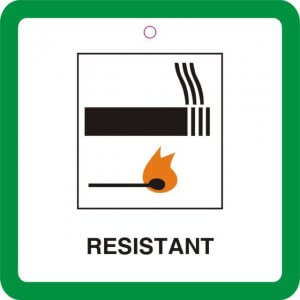 |
This label has a green border, with a picture of a lit cigarette and a burning match beneath, both inside a square. The word “resistant” features in capitals below. | For new furniture, this label indicates that the item is resistant to cigarettes and matches. |
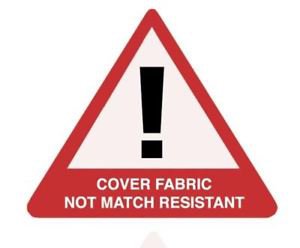 |
A red triangle, this label has black exclamation mark inside a white triangle with the words “cover fabric not match resistant” in capitals underneath. | This labels indicates that the fabric is not resistant to matches but the interliner has passed specified tests – it also means it meets filling requirements and is cigarette resistant. |
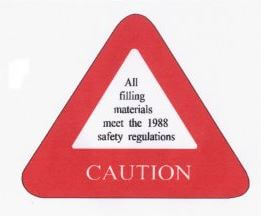 |
A red triangle with a white triangle which contains the text “All filling materials meet the 1988 safety regulations”. Below this is the word “caution” in capital letters. | This label indicates new furniture meeting the filling requirements and cigarette resistance. |
Record Keeping
It is important for all manufacturers, importers and retailers to be able to provide evidence of compliance with the fire safety regulations when it comes to applicable upholstery and furnishings. This evidence includes keeping records of:
- Supplier statements
- Test results of the furniture or components
- Correlation of results to the furniture
- Correlation of records to labels, batch numbers or marks
This information should be kept for five years from the date that the furniture is supplied to any retailer by the manufacturer and importer.
For retailers, there are a number of things you need to ensure the manufacturer or importer has provided in addition to the short label, including:
- Name and postal address for the first supplier in the UK
- Date of when the item was manufactured or imported
- Description of the filling materials
- Description of the covering materials
The retailer should then retain this information for five years, while a ‘Certificate of Compliance to the Furniture and Furnishing (Fire Safety) Regulations 1988’ is also recommended from the manufacturer or importer.
Additional Furniture & Furnishings Fire Safety FAQs
Do I need to perform a cigarette test for every cover and filling in my range if I manufacture domestic upholstered furniture?
While all materials do need to be tested, it has been agreed that this is sometimes unrealistic. The alternative is to provide the worst case test using the filling most likely to catch flame from cigarettes.
How long should upholstery fabrics which have been treated with flame retardant finishes be expected to retain those properties?
The flame retardant properties should be kept for between three and six cleans – wet or dry. Different cleaning processes will impact this differently, so cleaning instructions should be provided at the point of sale.
Are upholstered pet beds required to meet regulations?
There is some confusion about this, with some pointing to the fact they don’t fall under the remit of the regulations, while General Product Safety Regulations may come into play and require pet beds to meet Schedule 1 if they contain foam.
Do throws need to comply with regulations?
Being classed in a different category, these items do not necessarily need to comply, but if they are designed to be used as domestic covering for seating – say over a sofa – then they should be marketed and regulated as such.
Is inflatable furniture subject to regulations?
Plain, unadorned inflatable furniture does not need to comply with regulations, but those which come with fillings or materials as part of the structure do.
What rules apply to office chairs for a home office?
For any chairs of this type being sold to the domestic market must comply with regulations, whereas those sold to non-domestic markets would not have any requirements for labelling. It is recommended, however, that any foam should be compliant with Schedule 1.
Are there regulation requirements for wheelchairs?
A regular wheelchair will usually be covered through BS ISO 7176-16: 1997 for resistance to ignition. If the wheelchair in question has more upholstery than usual, this may mean it should be considered an upholstered chair and may be subject to regulations.
If you are unsure about any of the fire safety regulations that apply to your business – no matter which industry you’re in – then contact the professional team at Scutum London today. We can provide thorough fire risk assessments and any fire safety equipment you might require.
Request a Callback
Just fill in your details below and we'll get back to you as soon as we can!
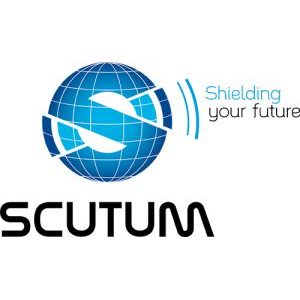
About Scutum London
Scutum London is a leading expert in fire safety and security solutions for businesses and organisations located across South East England, including London and Surrey.
From fire alarms, fire extinguishers and fire risk assessments to access control, CCTV and intruder alarm systems – and a lot more besides – we offer a comprehensive range of products and services designed to keep you, your business and your staff and visitors safe.
With decades of industry experience to call on, we’re proud to hold accreditations from leading trade associations and bodies such as British Approvals for Fire Equipment (BAFE), the British Fire Consortium, the Fire Industry Association (FIA) and Security Systems and Alarms Inspection Board (SSAIB).
If you’d like to find out more about Scutum London, get in touch with our friendly team or explore our products and services on our site.
